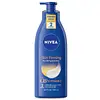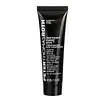What's inside
What's inside
 Key Ingredients
Key Ingredients

 Benefits
Benefits

 Concerns
Concerns

 Ingredients Side-by-side
Ingredients Side-by-side

Water
Skin ConditioningGlycerin
HumectantParaffinum Liquidum
EmollientC15-19 Alkane
SolventC12-15 Alkyl Benzoate
AntimicrobialPolyglyceryl-3 Distearate
EmulsifyingCetearyl Alcohol
EmollientMyristyl Alcohol
EmollientUbiquinone
AntioxidantSodium Ascorbyl Phosphate
AntioxidantSorbitan Stearate
EmulsifyingCera Microcristallina
Emulsion StabilisingHydrogenated Coco-Glycerides
EmollientDimethicone
EmollientCarbomer
Emulsion StabilisingSodium Hydroxide
BufferingBenzoic Acid
MaskingTrisodium EDTA
Phenoxyethanol
PreservativeEthylhexylglycerin
Skin ConditioningLinalool
PerfumingCitronellol
PerfumingBenzyl Alcohol
PerfumingAlpha-Isomethyl Ionone
PerfumingLimonene
PerfumingParfum
MaskingWater, Glycerin, Paraffinum Liquidum, C15-19 Alkane, C12-15 Alkyl Benzoate, Polyglyceryl-3 Distearate, Cetearyl Alcohol, Myristyl Alcohol, Ubiquinone, Sodium Ascorbyl Phosphate, Sorbitan Stearate, Cera Microcristallina, Hydrogenated Coco-Glycerides, Dimethicone, Carbomer, Sodium Hydroxide, Benzoic Acid, Trisodium EDTA, Phenoxyethanol, Ethylhexylglycerin, Linalool, Citronellol, Benzyl Alcohol, Alpha-Isomethyl Ionone, Limonene, Parfum
Water
Skin ConditioningGlycerin
HumectantButylene Glycol
HumectantSodium Silicate
BufferingMagnesium Aluminum Silicate
AbsorbentSodium Magnesium Fluorosilicate
AbrasivePalmitoyl Tetrapeptide-7
Skin ConditioningDipeptide-2
Skin ConditioningAscorbic Acid
AntioxidantTocopheryl Acetate
AntioxidantHesperidin Methyl Chalcone
AntioxidantRetinyl Palmitate
Skin ConditioningPanthenol
Skin ConditioningFoeniculum Vulgare Seed Extract
Skin ConditioningMedicago Sativa Seed Extract
Skin ConditioningCarrageenan
Argania Spinosa Kernel Extract
Skin ConditioningPEG-8 Dimethicone
EmulsifyingSilica
AbrasiveOctyldodecanol
EmollientSymphytum Officinale Leaf Extract
Skin ConditioningSodium Propoxyhydroxypropyl Thiosulfate Silica
BHT
AntioxidantDisodium EDTA
Hydrolyzed Lupine Protein
Skin ConditioningSteareth-20
CleansingSodium Cocoyl Glutamate
CleansingCarbomer
Emulsion StabilisingChlorhexidine Digluconate
AntimicrobialEthylhexylglycerin
Skin ConditioningPotassium Sorbate
PreservativeCitric Acid
BufferingSodium Citrate
BufferingSodium Benzoate
MaskingPhenoxyethanol
PreservativeWater, Glycerin, Butylene Glycol, Sodium Silicate, Magnesium Aluminum Silicate, Sodium Magnesium Fluorosilicate, Palmitoyl Tetrapeptide-7, Dipeptide-2, Ascorbic Acid, Tocopheryl Acetate, Hesperidin Methyl Chalcone, Retinyl Palmitate, Panthenol, Foeniculum Vulgare Seed Extract, Medicago Sativa Seed Extract, Carrageenan, Argania Spinosa Kernel Extract, PEG-8 Dimethicone, Silica, Octyldodecanol, Symphytum Officinale Leaf Extract, Sodium Propoxyhydroxypropyl Thiosulfate Silica, BHT, Disodium EDTA, Hydrolyzed Lupine Protein, Steareth-20, Sodium Cocoyl Glutamate, Carbomer, Chlorhexidine Digluconate, Ethylhexylglycerin, Potassium Sorbate, Citric Acid, Sodium Citrate, Sodium Benzoate, Phenoxyethanol
 Reviews
Reviews

Ingredients Explained
These ingredients are found in both products.
Ingredients higher up in an ingredient list are typically present in a larger amount.
Carbomer is a polymer of acrylic acid. Its main role is to create a gel consistency.
A high amount of carbomer can cause pilling or balling up of products. Don't worry, most products contain 1% or less of carbomer.
Ethylhexylglycerin (we can't pronounce this either) is commonly used as a preservative and skin softener. It is derived from glyceryl.
You might see Ethylhexylglycerin often paired with other preservatives such as phenoxyethanol. Ethylhexylglycerin has been found to increase the effectiveness of these other preservatives.
Glycerin is already naturally found in your skin. It helps moisturize and protect your skin.
A study from 2016 found glycerin to be more effective as a humectant than AHAs and hyaluronic acid.
As a humectant, it helps the skin stay hydrated by pulling moisture to your skin. The low molecular weight of glycerin allows it to pull moisture into the deeper layers of your skin.
Hydrated skin improves your skin barrier; Your skin barrier helps protect against irritants and bacteria.
Glycerin has also been found to have antimicrobial and antiviral properties. Due to these properties, glycerin is often used in wound and burn treatments.
In cosmetics, glycerin is usually derived from plants such as soybean or palm. However, it can also be sourced from animals, such as tallow or animal fat.
This ingredient is organic, colorless, odorless, and non-toxic.
Glycerin is the name for this ingredient in American English. British English uses Glycerol/Glycerine.
Learn more about GlycerinPhenoxyethanol is a preservative that has germicide, antimicrobial, and aromatic properties. Studies show that phenoxyethanol can prevent microbial growth. By itself, it has a scent that is similar to that of a rose.
It's often used in formulations along with Caprylyl Glycol to preserve the shelf life of products.
Water. It's the most common cosmetic ingredient of all. You'll usually see it at the top of ingredient lists, meaning that it makes up the largest part of the product.
So why is it so popular? Water most often acts as a solvent - this means that it helps dissolve other ingredients into the formulation.
You'll also recognize water as that liquid we all need to stay alive. If you see this, drink a glass of water. Stay hydrated!
Learn more about Water